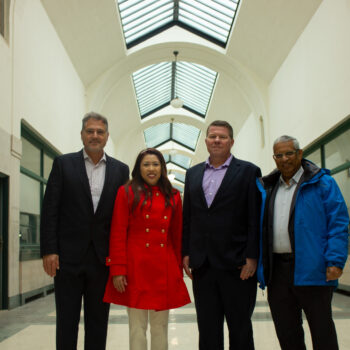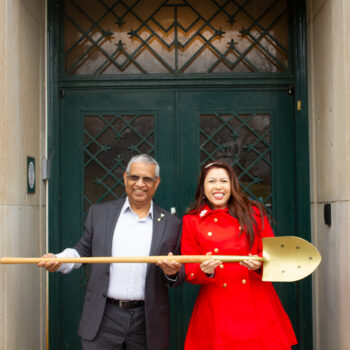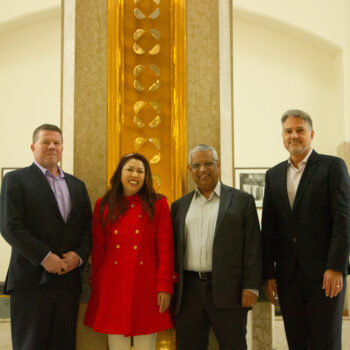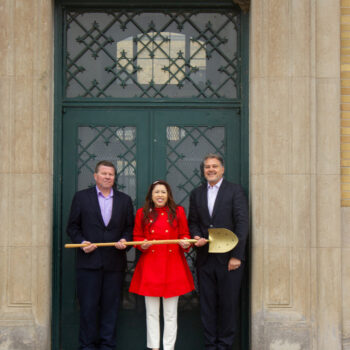ES&E Magazine sat down with Toronto Water and CIMA+ to discuss the City’s incredible diversity, and how asset management is benefiting from, and supporting, diverse organizations and Canada’s water sector.

It is fitting that a world-class city such as Toronto should host the American Water Works Association’s Annual Conference & Exposition (ACE) in 2023, and the International Water Association’s World Water Congress and Exposition in 2024. Not only is Toronto the country’s largest city, with a population of approximately 3 million, it is also one of the most diverse. Just under half of the city’s residents are immigrants and just over half—52%— are visible minorities.
“Diversity, Our Strength” is the motto of the City of Toronto, and this diversity is reflected in the hardworking professionals who manage the treatment plants and infrastructure that delivers over 1 billion litres of safe, clean drinking water each day to sustain the city and surrounding communities.
“In any organization, the biggest strength is the people—without a doubt,” said William Fernandes, director of water treatment and supply for Toronto Water, during our discussion. “You can’t do anything without people, and therefore our employees are the most important part of Toronto Water.”
Yet, while people are the greatest asset of any organization, especially one responsible with protecting public health and the environment, Toronto Water does have millions of physical assets to manage, and it is required to draw up Asset Management Plans to ensure the life cycle of everything from pumps to valves, and buildings to pipelines, is maximized.
Canada is one of only a few countries in the world to have mandated asset management planning and is recognized by the global community as a leader in this field.
Under Ontario Regulation 588/17 “Asset Management Planning for Municipal Infrastructure”, municipalities across the province are required to have Asset Management Plans (AMPs) in place in order to qualify for infrastructure funding and adhere to the regulation, and importantly, ensure the investments of tax payers are respected. “Essentially at its core, the Asset Investment/Management Plan is for evidence-based decision-making,” said Vanessa Chau, P.Eng., MIAM, CAMA, senior director – asset management advisory at CIMA+, and the founding member of Asset Management Ontario.
“COVID-19 accelerated the pace and need for asset management and investment planning to stretch each dollar and make sure that water treatment plants and other critical assets are maintained and have their service lives extended,” added Chau.

No matter the size, municipalities across Canada face challenges developing and updating AMPs, whether due to a lack of resources, the scale and complexity of their infrastructure, or even keeping up with best practices and developments.
As a result, municipalities and utilities rely on consultants to bring in outside expertise, while leveraging global best practices such as ISO 55000 and resources to assist with asset management planning.
One such consultant is CIMA+, a growing Canadian consulting engineering firm, that works extensively with Toronto Water and many other municipalities and utilities.
“We work in partnership with our municipal clients and no matter what the size, it is a true partnership,” said Troy Briggs, executive vice president of infrastructure at CIMA+. “This allows us to bring solutions that consider clients’ site-specific needs and make sure that we are providing a sustainable, value-added approach, and not just a cookie cutter.” By doing this, consultants help clients leverage those assets for many years to come so that the needs of growing communities can be met.
CIMA+, as a recognized corporate member of the global Institute of Asset Management (IAM) is also involved with water and wastewater industry associations. This includes the Ontario Water Works Association, where they are currently working to develop standards that can help smaller municipalities tackle some of the more complicated issues.
“We are constantly trying to give back and help smaller municipalities keep up with changing technology,” said Brian Sudic, vice president of infrastructure – Ontario, at CIMA+.
As the water and environment industry changes, so is the makeup of its workers and member companies, who are recognizing the importance and benefits of supporting diversity initiatives.
Engineering, which has long been primarily a male-dominated field, has seen increasing numbers of female engineering students and professionals in recent decades.
However, according to Engineers Canada, men still “vastly outnumber women in engineering” and the organization has set a goal of raising the percentage of newly licensed female engineers to 30% of the total by 2030.
 Chau is a contemporary trailblazer who has helped narrow the gender gap in engineering. She was one of the youngest female inductees into the prestigious Select Society of Sanitary Sludge Shovellers (5S) and was the youngest Water Environment Federation (WEF) delegate to represent Canada.
Chau is a contemporary trailblazer who has helped narrow the gender gap in engineering. She was one of the youngest female inductees into the prestigious Select Society of Sanitary Sludge Shovellers (5S) and was the youngest Water Environment Federation (WEF) delegate to represent Canada.
Recently, she was the only founding member of the IAM – Women in Asset Management – North American board, and she has been nominated to become the Canadian liaison for the IAM’s diversity and inclusion committee.
The IAM is a global association that will be holding its first North American conference in Toronto this October. Chau will also become one of the first “mentors” of the IAM’s global mentorship program.
Chau recalls her experiences as a young professional in the industry and how important it was to have mentors there for support.
“You can imagine that being a young person, it was very, very daunting,” said Chau. “So, mentors like William [Fernandes] and others of the 5S Society who were there for me, and able to guide me, were extremely important.”
Based on her personal experiences and knowledge from working both in Canada and internationally, Chau stresses that mentorship is integral to diversity, equity and inclusion action plans.
“Especially as a female in the water and wastewater industry, it is critical that we have mentors that have always been there to give us the allyship, sponsorship and guidance, in order for us to succeed,” said Chau.
At an organizational level, CIMA+ is working towards gender parity at all levels of the company to overcome this gender gap, and to deliver better service and expertise to its clients as a result.
In recognition of this, CIMA+ recently achieved bronze certification from the Women in Governance Organization, becoming the first engineering consultant in North America to do so, noted Sudic.
While gender is a key aspect of diversity, equity and inclusion (DEI), it is important to note that diversity extends beyond gender, and includes race, differences in age, physical and mental abilities, and more. Everything that makes up a person lends experience and insight that can improve how organizations are run, and how services are delivered.

For organizations that recognize the benefits of encouraging DEI but do not know where to begin, our group discussion noted some small steps that are easy to take and may offer big results.
These include, but are not limited to: increase women’s representation in leadership development; set targets to internship programs; advertise job openings to specific under-represented groups
who may not be aware of them; broaden interview stages to include qualified candidates from diverse backgrounds; and include social and diversity requirements in procurement criteria.
Tying it all together, Fernandes says that asset management and diversity efforts go hand in hand, as both are investments into an organization’s most important resources and tools, and furthermore, help to shape the public sector so that it reflects the public it serves.
“Assets are not just equipment,” said Fernandes. “Assets are humans, and that is where diversity and inclusion come in.” This sentiment is not unique to Toronto Water or even to Canada. According to Chau, who has spoken at numerous global asset management conferences, the international community agrees that people are at the heart of any successful asset management transformation program and outcomes.
“At its core, for any asset management transformation program to be successful, people are the most critical asset,” said Chau. “It is really about people and diversity, and innovative thinking.”
Peter Davey is the Managing and Online Editor of ES&E Magazine. Email peter@esemag.com
Asset management and diversity, equity and inclusion go hand in hand (esemag.com)